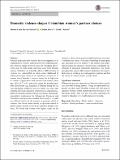Files in this item
Domestic violence shapes Colombian women’s partner choices
Item metadata
| dc.contributor.author | Borras Guevara, Martha Lucia | |
| dc.contributor.author | Batres, Carlota | |
| dc.contributor.author | Perrett, David Ian | |
| dc.date.accessioned | 2017-11-21T11:30:13Z | |
| dc.date.available | 2017-11-21T11:30:13Z | |
| dc.date.issued | 2017-12 | |
| dc.identifier | 251493025 | |
| dc.identifier | 05036c71-5f0d-4b17-a5b0-479208c00992 | |
| dc.identifier | 85035101306 | |
| dc.identifier | 000417949700007 | |
| dc.identifier.citation | Borras Guevara , M L , Batres , C & Perrett , D I 2017 , ' Domestic violence shapes Colombian women’s partner choices ' , Behavioral Ecology and Sociobiology , vol. 71 , no. 12 , 175 . https://doi.org/10.1007/s00265-017-2405-2 | en |
| dc.identifier.issn | 0340-5443 | |
| dc.identifier.other | ORCID: /0000-0002-6025-0939/work/64361025 | |
| dc.identifier.uri | https://hdl.handle.net/10023/12140 | |
| dc.description | This work was funded by Colciencias (Call 646), St Leonard’s College, University of St Andrews and The Russell Trust Foundation (Call 2016-2). | en |
| dc.description.abstract | Potential protection from violence has been suggested as an explanation for women’s preferences for more masculine partners. Previous studies, however, have not considered that violence may be multi-modal, and hence come from different sources. Therefore, we tested the effect of different fears of violence (i.e., vulnerability to public crime, likelihood of within-partnership violence) on masculinity preferences of women from Colombia, a country known for its high rates of violence. Eighty-three adult heterosexual women (mean age ± SD = 26.7 ± 6.01) answered a survey that included questions about health (e.g. frequency of illnesses during the last year and during childhood), access to media (e.g. time spent watching television, frequency of internet use), education (i.e., highest level achieved) and violence perceptions. Participants’ masculinity preferences for Salvadoran, European and Colombian male faces were recorded. Factor analysis revealed two different factors for the answers to questions related to violence. One factor loaded mostly on questions related to public violence and the second factor related to domestic violence. We found that women with higher scores on the domestic violence factor preferred significantly less masculine Colombian male faces. Even after controlling for participant age, education, access to media (TV and internet) and health-related factors, the domestic violence factor contributed significantly to explaining masculinity preferences. The results presented here suggest that women’s preferences for masculinity may be a strategy to avoid aggressive partners and that the source of violence matters in mate choice. | |
| dc.format.extent | 1552594 | |
| dc.language.iso | eng | |
| dc.relation.ispartof | Behavioral Ecology and Sociobiology | en |
| dc.subject | Masculinity | en |
| dc.subject | Public violence | en |
| dc.subject | Domestic violence | en |
| dc.subject | Partner preferences | en |
| dc.subject | Intra-sexual selection | en |
| dc.subject | BF Psychology | en |
| dc.subject | HQ The family. Marriage. Woman | en |
| dc.subject | DAS | en |
| dc.subject | BDC | en |
| dc.subject | SDG 5 - Gender Equality | en |
| dc.subject | SDG 16 - Peace, Justice and Strong Institutions | en |
| dc.subject.lcc | BF | en |
| dc.subject.lcc | HQ | en |
| dc.title | Domestic violence shapes Colombian women’s partner choices | en |
| dc.type | Journal article | en |
| dc.contributor.institution | University of St Andrews. School of Psychology and Neuroscience | en |
| dc.identifier.doi | 10.1007/s00265-017-2405-2 | |
| dc.description.status | Peer reviewed | en |
This item appears in the following Collection(s)
Items in the St Andrews Research Repository are protected by copyright, with all rights reserved, unless otherwise indicated.

